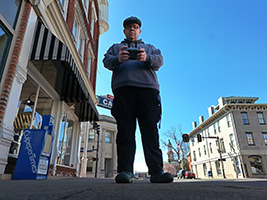The Roanoke Star
Fog
When I did The Schumin Web Photo Essay Blitz in March 2002, it appeared that my weekends were cursed by rain. When I was in Northern Virginia the Saturday before, I had planned to photograph Old Town Alexandria, but it was raining so hard at that point that I had to cancel it. The Saturday after this, I went to Roanoke, with the main target being the famous Roanoke Star on Mill Mountain. It was actively raining during part of my trip down to Roanoke from Stuarts Draft, and I was hoping against hope that I didn’t go the hour-and-change to Roanoke from Stuarts Draft to be rained out, since everything I wanted to do in Roanoke was outside. But as it turned out, it was actually not that bad. However, I was fiercely determined to do the planned shoot, and so despite a thick fog surrounding the top of Mill Mountain, I went up to the star, thinking, I’m going to shoot this photo set even if I can’t see it. It was completely deserted up at the star due to the fog. However, in looking at the pictures later, the fog, while it completely obscured the view from the overlook, provided a sense of depth to some of the photos. Basically, because as you looked further and further away, you were looking through more and more fog, things appeared in different shades, providing better pictures than would have been achieved otherwise.
Welcome to the Roanoke Star, the world’s largest man-made star. And here it is, peeking out behind the fog.
One hundred feet of steel, holding up a giant mass of neon tubing, wires, and more.
And the peak of the star stands tall, trying its best to show itself to me despite the fog.
The star itself is quite flat. The only depth in the star is in the steel support structure that holds it up.
On each of the star’s three levels, there are three tubes – red, white, and blue. Since September 11, 2001, the star had been lit in red, white, and blue. Previously, the star was lit in all white, and all red on days when there is a traffic fatality in the city.
Down below, foliage tries to hide some of the support structure in order to conceal the more functional aspects of the star, and improve the view.
Meanwhile, on the overlook in front of the star, you can’t see a thing.
In these views from behind the support structure, steel beams connect to the back of the star itself.
The entire structure comes to a point at the top of the star.
As mentioned previously, the fog provided an otherwise-not-available depth to the images. Such a complex support structure for a giant geometric shape.
The Roanoke Star may not have been a massive feat of engineering, but nonetheless, I was impressed.
The star in these edge-on views appears almost invisible.





























